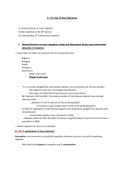8 - The Age of Mass Migration
1) General theories on mass migration
2) Mass migration in the 19th century
3) Understanding 19th century mass migration
1. General theories on mass migration: origin and destination factors and, intervening
obstacles in migration
→ many slides w/ tables and maps (put the most important ones)
- Migrants
- Refugees
- Expats
- Foreigners
- Allochtonen
- What is the name?
- People on the move
- “It is commonly thought that international migration has accelerated over the past decades
- that migrants travel over increasingly long distances
- that origins and destinations have become much more diverse
- BUT, Between 1950 and 2017, the relative number of international migrants has remained
relatively stable,
- → Between 2.7 and 3.3 percent of the world population
- increased at a pace roughly equal to that of the world population.
- ALTHOUGH, registration of international migrants and, particularly, refugees has improved over
recent decades
- Questionable whether it has increased in reality.
- → Between 1846 and 1924: 48 million Europeans emigrated (about 12 percent of the European
population in 1900)
→ Global migration has thus not accelerated
1.1. Macro explanations of mass migration:
Assumption: socio-economic and political inequalities between countries = crucial for explaining
migration
- Affect both the inception of migration and its perpetuation
,Based on a “Push and Pull” model of migration
- Focuses on the disparity in conditions between the place of origin and the place of destination)
- Push: induce people to leave their location (poverty, political instability, religious
intolerance, … )
- Pull: prompt people to move to a new location (democratic climate, religious tolerance,
booming economy, job opportunities, … )
- Intervening obstacles: distance, knowledge, prior migration patterns, migration policies,
…
- “International migrants accounted for a relatively small share of the world’s total population, 3.5
per cent in 2019.”
- “In high-income countries, international migrants constituted 14.0 per cent of the total
population.”
*Registered foreigner in Belgium come fro various nationality (largest: Italians) → distributed unequally
between Belgian municipalities (eg: majority of Moroccans in Antwerpen)
1.2. Meso explanations to mass migration:
Meso factors:
- Chain migration, social and/or professional networks, information flows (framing of the US
migration policy), transport facilities (development of shipping routes), go-betweens and fixers,
…
- Legal restrictions, government policies, employment schemes, …
- Remittances (migrants abroad sending money home): facilitating migration of poorer
family/community members.
*In some countries the remittances are the major % of their GDP.
Migration = a web of social and spatial interactions
- Chain migration helps explain why migration % oftentimes increase after a first wave of
moderate migration
1.3. Micro explanations to mass migration:
Micro-level: household & individual characteristics (subjective and individual reasons that push or
explain mass migration)
- Age, gender, skills, … [primary aspects]
, - Social, economic and cultural capital
- “mobility” culture, and affective relations with migrant communities abroad
Micro factors help explain:
- → It is typically not the “poorest of the poor” who migrate
- There is a strong relationship between migration, poverty and its alleviation (it is usually
those who get a slightly better economic or educational situation who get the means to
migrate, and not the “poorest of the poor”)
- … but poverty in itself may not be the main driver of migration (nuancing of
macro-patterns)
- The importance of individual and social characteristics
- Individual characteristics: age, gender, skills/education
- Social determinants: social milieu and networks
So, migration is a complex phenomenon; can only be explained by integrating different levels of
analysis (macro/meso/micro) and by accounting for their interaction.
Migration is a social and spatial process
- Via interpersonal contacts
- Embedded in broader spatial interactions
- Path dependent & self-reinforcing
- Selective process
- Creates migration circuits and patterns
2. Mass migration in the 19th century
Six forms of migration (Lucassen and Lucassen, 2009):
- Emigration = migration from Europe to non-European destinations, including colonial, overseas
migration
- Immigration = migration from other continents to Europe
- Colonization = Settlement in ‘empty’ or sparsely populated spaces within Europe
- Predominantly rural settlement of the Russian forest and steppe zones
- Migration to cities = movements to cities of more than 10,000 inhabitants, predominantly from
the countryside
- Seasonal migration = seasonal work migration
- Soldiers and Sailors = migration of sailors and soldiers
** Emigration from Europe to other continents has increased significantly in the last two centuries (from
1850)




